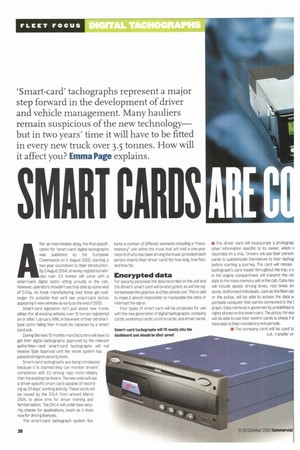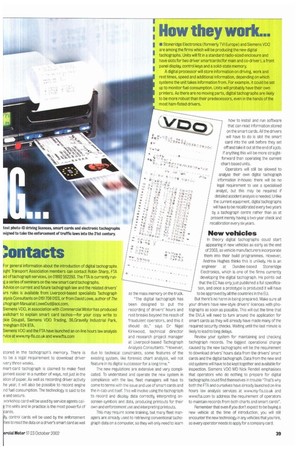SMART CAR
Page 38

Page 39

If you've noticed an error in this article please click here to report it so we can fix it.
'Smart-card' tachographs represent a major step forward in the development of driver and vehicle management. Many hauliers remain suspicious of the new technology— but in two years' time it will have to be fitted in every new truck over 3.5 tonnes. How will
it affect you? Emma Page explains.
After an interminable delay, the final specification for 'smart-card' digital tachographs was published by the European Commission on 5 August 2002, starling a two-year countdown to their introduction. By 5 August 2004, ail newly-registered vehicles over 3.5 tonnes will come with a smart-card digital tacho sitting proudly in the cab. However. operators shouldn't see that date as some kind of 0-Day. As truck manufacturing lead times get ever longer it's possible that we'll see smart-card tachos appearing in new vehicles as early as the end of 2003.
Smart-card legislation isn't just about new trucks either. For all existing vehicles over 12-tonnes registered on or after 1January 1996, in the event of their old charttype Mello fairing then it must be replaced by a smart card unit.
During the next 10 months manufacturers will have to get their digital tachographs approved by the relevant authorities—and smart-card tachographs will not receive Type Approval until the whole system has passed stringent security tests.
Smart-card tachographs are being introduced because it is claimed they can monitor drivers' compliance with EU driving regs more reliably than the existing hardware. The new units will use a driver-specific smart card capable of record ing up 28 days' working activity. These cards will be issued by the DVLA from around March 2304, to allow time for driver training and familiarisation. The DVLA will undertake security checks for applications, much as it does now for driving licences.
The smart-card tachograph system fea
tures a number of different elements including a "massmemory" unit within the truck that will hold a one-year record of who has been driving the truck (provided each person inserts their driver card) for how king, how fast, and how far.
Encrypted data
For security purposes the data recorded on the unit and the driver's smart card will be encrypted, as will the signal between the gearbox and the vehicle unit. This is said to make it almost impossible to manipulate the data or interrupt the signal.
Four types of smart card will be produced for use with the new generation of digital tachographs: company cards; workshop cards; control cards; and driver cards. • The driver card will incorporate a photograpi other information specific to its owner, which v recorded on a chip. Drivers will use their person cards to authenticate themselves to their tachog before starting a journey. The card will remain tachograph's card reader throughout the trip; a s in the engine compartment will transmit the re( data to the mass memory unit in the cab. Data reci will include speed, driving times, rest times an tance. Authorised individuals, such as the fleet opE or the police, will be able to access the data ui portable computer that can be connected to the t graph. Data retrieval is governed by predefined a rights stored on the smart card. The police, for exa will be able to use their control cards to check if d have kept to their mandatory rest periods.
The company card will be used to out, transfer or stored in the tachograph's memory. There is to be a legal requirement to download driver !very three weeks.
mart-card tachograph is claimed to make fleet ement easier in a number of ways, not just in the ation of paper. As well as recording driver activity he year, it will also be possible to record engine rid fuel consumption. The technology is said to be e and secure.
workshop card will be used by service agents callthe units and in practice is the most powerful of arias, ly control cards will be used by the enforcement ities to read the data on a driver's smart card as well as the mass memory on the truck.
"The digital tachograph has been designed to put the recording of drivers' hours and rest breaks beyond the reach of fraudulent operators, and this it should do," says Dr Nigel Kirkwood, technical director and research project manager at Liverpool-based Tachograph Analysis Consultants. "However, due to technical constraints, some features of the existing system, like forensic chart analysis, will not feature in its digital successor for a long time."
The new regulations are extensive and very complicated. To understand and operate the new system in compliance with the law, fleet managers will have to come to terms with the issue and use of smart cards and the in-cab unit itself This will involve using the tachograph to record and display data correctly, interpreting onscreen symbols and data, producing printouts for their own and enforcement use and interpreting printouts.
This may require some training, but many fleet managers are already used to retrieving conventional tachograph data on a computer, so they will only need to learn how to install and run software that can read information stored on the smart cards. All the drivers will have to do is slot the smart card into the unit before they set off and take it out at the end of ajob.
If anything this will be more straight forward than operating the current chart-based units, Operators will still be allowed to analyse their own digital tachograph information in-house: there will be no legal requirement to use a specialised analyst, but this may be required if detailed accident analysis is needed. Unlike the current equipment, digital tachographs will have to be recalibrated every two years by a tachograph centre rather than as at present merely having a two-year check and recalibration every six years.
New vehicles
In theory digital tachographs could start appearing in new vehicles as early as the end of 2003, as vehicle manufacturers incorporate them into their build programmes. However, Andrew Hughes thinks thls is unlikely. He is an engineer at Dundee-based Stoneridge Electronics, which is one of the firms currently developing the digital tachograph. He points out that the EC has only just published a full specification, and once a prototype is produced it will have to be approved by all the countries in the EU.
But there's no harm in being prepared. Make sure all your drivers have new-style drivers' licences with photographs as soon as possible. This will cut the time that the DVLA will need to turn around the application for smart cards as they will already have made many of the required security checks. Waiting until the last minute is likely to lead to long delays.
Review your system for maintaining and checking tachograph records. The biggest operational change caused by the new tachographs will be the requirement to download drivers' hours data from the drivers' smart cards and the digital tachograph. Data from the new and old systems will have to be kept together and available for inspection. Siemens VDO MD Nick Rendell emphasises that operators who do nothing to prepare for digital tachographs could find themselves in trouble "That's why both the ETA and ourselves have already launched on-line hours law analysis services at www.my-fis.co.uk and wwwita.com to address the requirement of operators to maintain records from both charts and smart cards".
































































































































































